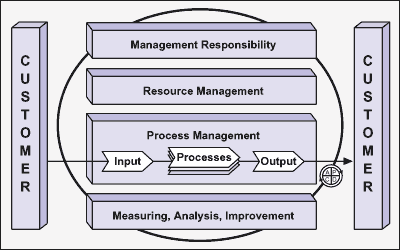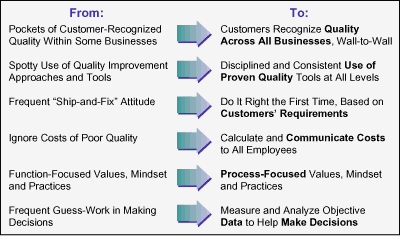
Six Sigma and ISO 9000 can be highly complementary. Unfortunately, the two concepts often are driven by different project leaders, competing for resources and therefore not delivering the best results. There is, however, a way to combined the power of both concepts to add value to a company.
An Overview of ISO 9000
ISO 9000 is a well-established international standard for quality management systems for all kinds of companies in nearly every industry. Developed by Technical Committee 176 of the International Organization for Standardization (ISO), it has evolved – based on input from companies and institutions – from a theoretical set of requirements in 1987 to a practical and process-oriented approach to assess the framework for quality management in 2000.

ISO 9000:2000 offers a process model (Figure 1) and these underlying quality management principles:
- Principle 1 – Customer focus
- Principle 2 – Leadership
- Principle 3 – Involvement of people
- Principle 4 – Process approach
- Principle 5 – System approach to management
- Principle 6 – Continual improvement
- Principle 7 – Factual approach to decision making
- Principle 8 – Mutually beneficial supplier relationships
In the early stage of ISO 9000, there was no focus on continuous improvement apart from quality management system elements such as “control of non-conforming products” and “corrective and preventive action.” Although, ISO 9000:2000 puts much more focus on customer orientation, the process approach to continuous improvement and fact-based management, this standard does not propose tools to meet those requirements. (References from “Six Sigma and ISO 9000:2000” by Praveen Gupta, February 2002 issue of Circuits Assembly.)
One of the strengths of ISO 9000 has always been those requirements that make an organization assess itself, which starts with internal audits once or twice a year and goes on to annual external third party audits performed by accredited certifying bodies. These requirements keep the ISO 9000 quality management system alive and up-to-date, avoiding the idea that ISO certification is a one-time event, a project just to reach the certification and to show the paperwork.
An Overview of Six Sigma
Six Sigma is a methodology for process improvement put together by Motorola in the mid-1980s and fine-tuned by such companies as AlliedSignal and General Electric in the 1990s. It has been developed into a way of doing business in some companies: “Completely satisfying customer needs profitably!” (former GE CEO Jack Welch). Within the methodology, Six Sigma has a rich and powerful toolbox for nearly every kind of process analysis, process management, process improvement and process design. This toolbox was developed by Six Sigma pioneers looking at the huge variety of tools and approaches developed during the decades when quality debuted as a major corporate issue. Thus, Six Sigma generally uses and enhances well-known and proven techniques. Although it had its start in manufacturing, it applies to all processes within any kind of company, Six Sigma’s capability to deliver impressive business results is broadly recognized.

What about the long-term impact of Six Sigma? Companies like General Electric and Johnson & Johnson have been deploying Six Sigma for years. How do they make sure that over time there is continuity in their Six Sigma initiative and, moreover, continuous improvement and customization of the principles applied in different business areas? Most Six Sigma companies recognize the different phases of the application of Six Sigma – starting from “enthusiastic support” through “implementation and delivery of results” and finally “now it’s done, let’s go back to our normal business.” Especially at the later stage, Six Sigma needs strong leadership and tools to sustain the initiative. Therefore, some of these companies developed their own framework to assess the Six Sigma system. At General Electric, the corporate audit staff (normally responsible for financial audits) has been trained to conduct Six Sigma assessments. The contents of these gap assessments included:
- Leadership – Quality culture, Six Sigma assessment and gap closure, communication
- Measurements and Projects – Customer satisfaction results, process indicators, project initiation and progress, dashboards
- Training – All staff training and involvement, Six Sigma training for different areas and levels
- Resources – Appointment of Belts (internal consultants to drive Six Sigma projects), dedication of leaders to deploy and maintain Six Sigma
- Results – Tangible and intangible results of process improvement
- Reward and Recognition: Scorecards, various ways to recognize individuals and teams for their improvement contribution and for delivering results.
After having implemented this assessment system, the whole organization recognized a restart of Six Sigma and the full awareness that this is much more than a “flavor of the month.”
Use Six Sigma Tools to Meet ISO 9000 Requirements
One of the major differences between both systems is that ISO 9000 is a shell of requirements without any tools, whereas Six Sigma is a methodology connecting tools and procedures for applying these tools through a “red thread.”
Requirements of ISO 9000:2000 are, for example:
- Define quality management information needs
- Collect quality management system data
- Provide quality management information
- Improve quality management system
Tools provided by Six Sigma to meet these requirements are, for example:
- Dashboards as a set of key performance indicators to monitor all processes at a reasonable degree for all relevant managerial levels.
- Operational definitions to describe exactly how, when, where, with which tools, by whom, how often and how much data should be collected. Additionally, Six Sigma provides tools to address such questions as sample size and precision as well as capability, repeatability and reproducibility of data collection.
- Data displays to help draw business-relevant conclusions and tests to justify the significance of conclusions drawn from data collected.
- DMAIC: Define-Measure-Analyze-Improve-Control as a methodology for process improvement at a project level, which is – after necessary customization – applicable to all kinds of processes.
Use the ISO 9000 Framework to Assess a Six Sigma System
Looking at the new ISO 9000:2000 requirements and comparing these requirements with the self-developed Six Sigma gap-analysis shows the possibility of connecting both approaches and systems with each other. Six Sigma does not come with the assessment tool per se. This tool needs to be added after a certain time frame in order to keep the ball rolling and in order to help Six Sigma get into the company’s bloodstream. ISO 9000 is designed to assess companies based on both external and internal requirements and to help close the gaps on a mid-term and long-term basis. By adding typical Six Sigma requirements to the ISO 9000:2000 internal audit questionnaires, a company can make Six Sigma part of its quality management system and improve the effectiveness and efficiency of the Six Sigma initiative significantly.
A side effect is that both approaches get aligned and do not compete for resources any longer. Since the goals of the two approaches are the same, there is a greater likelihood of an increase in bottom-line and top-line results on a long-term basis to increase customer satisfaction and employee commitment.
Conclusion: Improve Credibility and Sustainability
It is a waste to have a quality management system and process improvement approach existing side-by-side without any integration. Aligning ISO 9000 and Six Sigma can help improve the credibility of the ISO 9000 quality management system and the sustainability of the Six Sigma initiative at the same time. It can save resources and investments; and it enriches the way to manage the business.